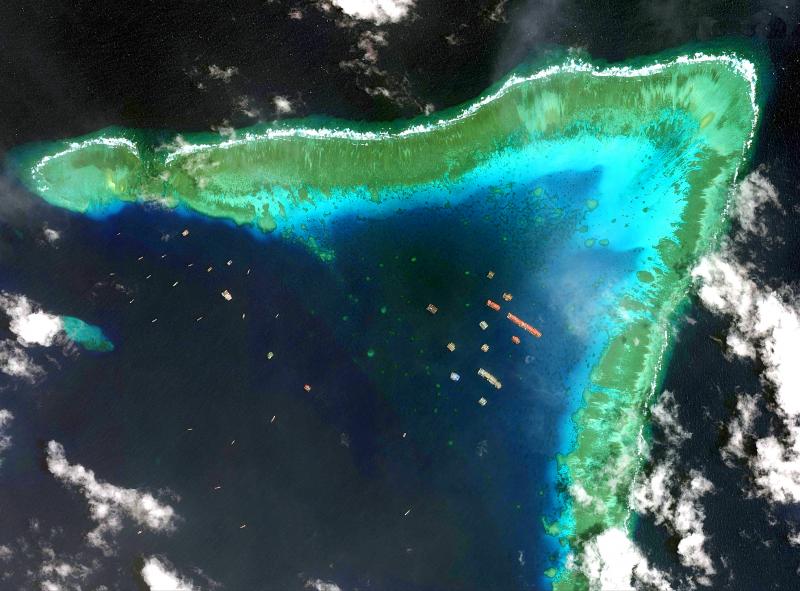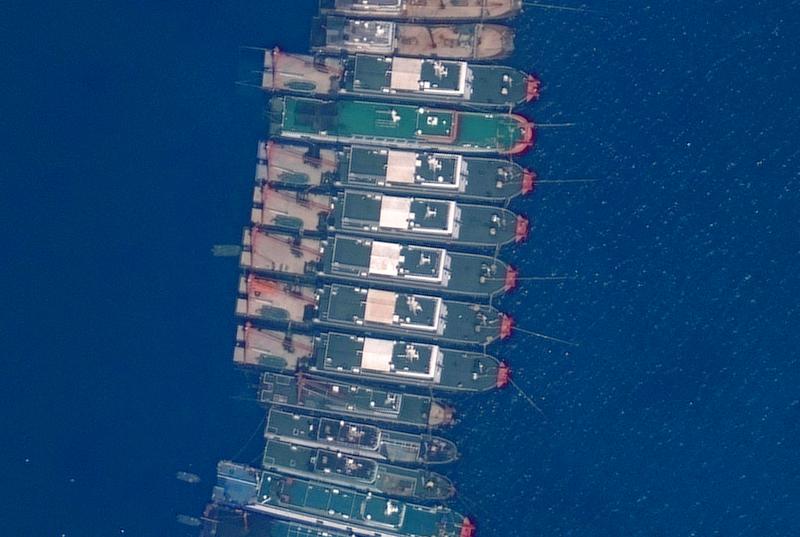For the last two decades, there has been a growing chorus of think pieces arguing that the US should clarify its position on Taiwan and end its policy of “strategic ambiguity,” its refusal to announce an official position stating clearly whether and under what conditions it would defend Taiwan.
Like antibodies rushing to defend a breach in the skin, such articles then attract wave after wave of essays contending that ending strategic ambiguity is a bad idea.
PRECEDENTS

Photo: Maxar Technologies via AFP
Yet, just off Taiwan are two cases that can shed light on the problems at the heart of strategic ambiguity, the Philippines and Japan. Farther off, the subcontinent offers several others, including India, Nepal and Bhutan.
If observers wish to see what might happen when the US commitment is “clear,” they need merely consider the cases of the Philippines and Japan, both of which have mutual defense treaties with the US that compel it to come to their aid if attacked.
At present, China occupies features in the South China Sea that indisputably belong to the Philippines, such as Scarborough Shoal (Huangyan Island, 黃岩島, also claimed by Taiwan). It uses both fishing boats and paramilitary vessels to carry out these activities. While the US has made noise, Chinese boats remain at Scarborough and elsewhere in the South China Sea.

Photo: Reuters
This occupation, though overt theft, has not triggered a US military response.
Similarly, the Diaoyutai Islands (釣魚台, known as the Senkaku Islands in Japan, also claimed by Taiwan and China), Japanese since the late 19th century, have been the site of numerous incursions by Chinese boats in recent years. The US has publicly stated that it includes the Senkakus in its mutual defense treaty with Tokyo, and years ago, even carried out wargames there with Japanese defense forces.
This clarity — repeated on a regular basis by US officials — has not deterred China from pushing its ships and aircraft into the area, and then withdrawing them.
Indeed, looking at the Philippines and Japanese cases, it is not difficult to conclude that US clarity actually makes it easier for China to carry out its provocative acts of aggression, because the treaty lets China know what it can and cannot do. It also enables China to locate and then define the boundaries of US action via constant testing of them.
Beijing is carrying out some of the same activities at the moment against Taiwan, testing Taiwan with planes, but more importantly, with sand dredgers off Matsu’s coast. This has forced Taiwan to conduct round-the-clock patrols of the area, even as Matsu’s communications cables and tourism are disrupted by the Chinese dredgers. China deploys hundreds of dredgers, against less than a dozen Coast Guard vessels from Taiwan.
Yet, it has not physically occupied any features that are indisputably Taiwanese, such as islands in Penghu. Nor have the dredgers appeared elsewhere off Taiwan-controlled waters. When Taiwan Coast Guard ships appear, the dredgers generally withdraw, to return when they are gone.
Beijing does not know how the US will react to more aggressive moves against the possessions of Taiwan. Perhaps that is encouraging restraint.
Perhaps it is merely a matter of time.
Those who argue that the US should end its policy of strategic ambiguity should take a hard look at Philippines and Japan, and the US (non-)response to Chinese incursions.
FICKLE US POLICY?
They should also consider the fickleness of US policy, shifting from year to year and administration to administration. Imagine, for example, if the hopelessly weak and compromised administration of president Barack Obama had ended strategic ambiguity. What definition of US policy would we now be constrained by?
Recently many observers have been cheered by strong US statements about its relationship with Taiwan. Indeed, some officials have even said that Taiwan is no longer viewed as a problem by the US.
For example, a State Department official said: “Taiwan is not looked at as a problem anymore, but as a success story.” Sorry, my bad. That was from 2002.
Meanwhile, China is also pursuing policies of expansion in the Himalayas, a major flashpoint. The seizure of land features belonging to India brought a sharp response from New Delhi. China is certain that India will react vigorously, yet it continues its expansionist policies.
It also has seized land belonging to Nepal and to Bhutan. Surveys done last year by the government of Nepal indicated that land in seven different districts had been seized by China. Similarly, this year it was revealed that China had been constructing roads, buildings and military facilities in a valley belonging to Bhutan since 2015.
Nepal, Bhutan, and Philippines are militarily weak, and can do little against Chinese aggression. India and Japan are much stronger.
None of this array of postures and strengths seems to mean much in the face of Chinese aggression. China presses on them all, weak or strong, allied or alone, carefully but persistently.
Commentators often forget that another purpose of strategic ambiguity is to deter Taipei, though this aspect of the policy has been less explored in recent years. Strategic ambiguity thus deters both sides, at least in the US view.
PRETEXT OF CIVIL UNREST
It is not difficult to imagine how, if the US had a clear policy of intervention in the case of Chinese attack, the situation could be exploited by a Chinese Nationalist Party (KMT) president. If a KMT president could incite “civil unrest” in Taiwan through some absurdly pro-China move, like China-friendly former president Ma Ying-jeou (馬英九) did with the two trade and services agreements, what is to stop him from calling for People’s Liberation Army troops to “restore order?”
What if a KMT president were to invite Chinese troops in to help with typhoon relief? How would Washington react, if its red lines had already been drawn elsewhere?
At the moment, strategic ambiguity is important not only because China does not know what the US would do in the case of an invasion, but also because Beijing does not know where the boundaries of the US response are located. Literally anything from a full-scale invasion to a White House fit of pique could trigger an armed response from Washington.
Yet, what the incursions into others’ territories in the Himalayas, in the South China and in the Senkakus suggest is that, in the long term, “strategic ambiguity” is simply going to become irrelevant.
Beijing will do what Beijing will do: “salami slicing” against its opponents irrespective of their policies or positions, their strengths or weaknesses. The current debate over “strategic ambiguity” in US circles signals, not the coming of a shift in the US position, but its rapidly growing irrelevance.
Notes from Central Taiwan is a column written by long-term resident Michael Turton, who provides incisive commentary informed by three decades of living in and writing about his adoptive country. The views expressed here are his own.

The 1990s were a turbulent time for the Chinese Nationalist Party’s (KMT) patronage factions. For a look at how they formed, check out the March 2 “Deep Dives.” In the boom years of the 1980s and 1990s the factions amassed fortunes from corruption, access to the levers of local government and prime access to property. They also moved into industries like construction and the gravel business, devastating river ecosystems while the governments they controlled looked the other way. By this period, the factions had largely carved out geographical feifdoms in the local jurisdictions the national KMT restrained them to. For example,

The remains of this Japanese-era trail designed to protect the camphor industry make for a scenic day-hike, a fascinating overnight hike or a challenging multi-day adventure Maolin District (茂林) in Kaohsiung is well known for beautiful roadside scenery, waterfalls, the annual butterfly migration and indigenous culture. A lesser known but worthwhile destination here lies along the very top of the valley: the Liugui Security Path (六龜警備道). This relic of the Japanese era once isolated the Maolin valley from the outside world but now serves to draw tourists in. The path originally ran for about 50km, but not all of this trail is still easily walkable. The nicest section for a simple day hike is the heavily trafficked southern section above Maolin and Wanshan (萬山) villages. Remains of

With over 100 works on display, this is Louise Bourgeois’ first solo show in Taiwan. Visitors are invited to traverse her world of love and hate, vengeance and acceptance, trauma and reconciliation. Dominating the entrance, the nine-foot-tall Crouching Spider (2003) greets visitors. The creature looms behind the glass facade, symbolic protector and gatekeeper to the intimate journey ahead. Bourgeois, best known for her giant spider sculptures, is one of the most influential artist of the twentieth century. Blending vulnerability and defiance through themes of sexuality, trauma and identity, her work reshaped the landscape of contemporary art with fearless honesty. “People are influenced by

Ten years ago, English National Ballet (ENB) premiered Akram Khan’s reimagining of Giselle. It quickly became recognized as a 21st-century masterpiece. Next month, local audiences get their chance to experience it when the company embark on a three-week tour of Taiwan. Former ENB artistic director Tamara Rojo, who commissioned the ballet, believes firmly that if ballet is to remain alive, works have to be revisited and made relevant to audiences of today. Even so, Khan was a bold choice of choreographer. While one of Britain’s foremost choreographers, he had never previously tackled a reimagining of a classical ballet, so Giselle was